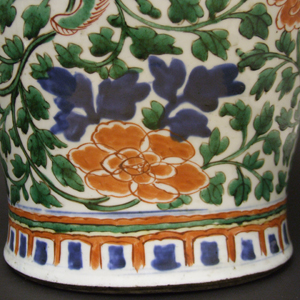
SHUNZHI 1644 – 1661 Transitional Porcelain
A Transitional Porcelain Wucai Jar and Cover, Shunzhi Period 1644-1661. The Transitional Porcelain Baluster Jar is Decorated in a Rich Underglaze Cobalt Blue and Strong Bright Overglaze Enamels. Decorated with Fu Dogs (Buddhist Lion) Among Flowering Peony.
SOLD
- Condition
- N/A
- Size
- Height : 39.5 cm (15 1/2 inches)
- Provenance
- N/A
- Stock number
- 23052
Information
Wucai :
Wucai means five coloured decoration. This consists of the overglaze enamel colours ; red, green, and yellow, underglaze cobalt blue and the white of the porcelain itself.
Shunzhi 1644-1661 :
The Shunzhi emperor (lived 1638 to 1661) was the second emperor of the Manchu Qing dynasty, and the first Qing emperor to rule over China proper. He ascended to the throne aged five (six sui according to traditional Chinese count) in 1643 upon the death of his father, Hong Taiji, but actual power during the early part of his reign lay in the hands of the appointed regents, Princes Dorgon and Jirgalang. With the Qing pacification of the former Ming provinces almost complete, he died still a young man, although in circumstances that have lent themselves to rumour and speculation. In the midst of much upheaval, the Manchus seized control of Beijing in June 1644, and in October of the same year the Shunzhi emperor`s uncle, the chief regent Prince, proclaimed the Qing dynasty to be the legitimate successor to the Ming dynasty. Therefore, although the Shunzhi emperor was not the founder of the Qing dynasty, he was the first Qing emperor of China. His mother was Empress Dowager Xiao Zhuang Wen who was an excellent politician during the period. The young emperor disliked his uncle, the chief regent Prince Dorgon, and after Dorgon`s death in 1650 the emperor stripped both him and Dorgon`s brother, Prince Dodo, of their titles, although he was only 12 years old at the time. During his short reign, the Shunzhi emperor encouraged the Han Chinese to participate in government activities. He was a scholar and employed Han Chinese to teach his children. The emperor married his mother`s niece, but demoted the empress several years later. Four months after his favourite concubine passed away, he died of smallpox. Before he passed away, he appointed four regents to help his son, Hiowan Yei. They were Oboi, Sonin, Suksaha and Ebilun. It was believed that the young emperor did not pass away but left the palace to become a monk.
Fu Dog, Buddhist Lion, Fo Dog :
When Buddhist priests, or possibly traders, brought stories to China about stone dogs guarding the entry to Indian Buddhist temples, Chinese sculptors modelled statues after native dogs for use outside their temples. The mythic version of the animal, was known as the Dog of Fo, the word Fo being Chinese for Buddha. The Buddhist version of the dog was originally introduced to Han China as the protector of dharma and these dogs have been found in religious art as early as c.200 BC. Gradually they were incorporated as guardians of the Chinese Imperial dharm. However, Chinese sensitivity metamorphosed the dog into a lion, even though lions were not indigenous to China, since this seems more appropriate to the dignity of an emperor when he used the beasts to guard his gates. The mythic dog is sometimes associated with feng shui, and are often called Fu Dogs. Fu means `happiness` in Chinese; however, the term `Fu Dog` and its variant Foo Dog, are not used in Chinese. Instead, they are known as Rui Shi (`auspicious lions`) or simply Shi (lions). There are various styles of imperial guardian lions reflecting influences from different time periods, imperial dynasties, and regions of China. These styles vary in their artistic detail and adornment as well as in the depiction of the lions from fierce to serene.






